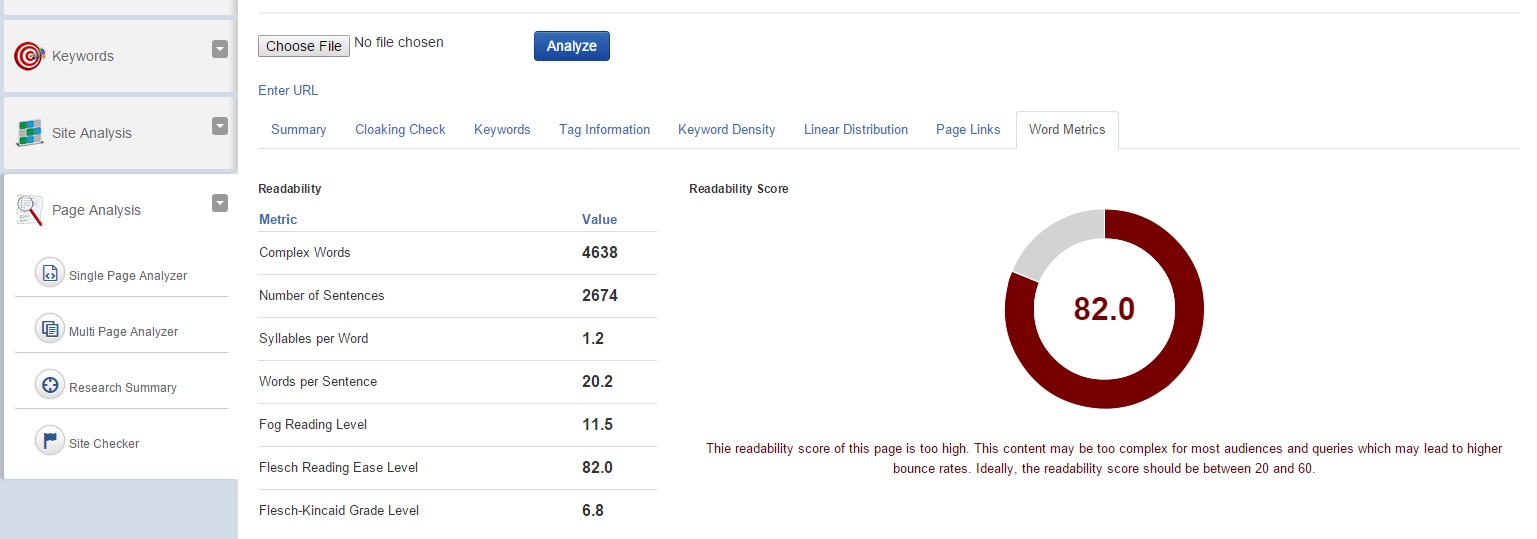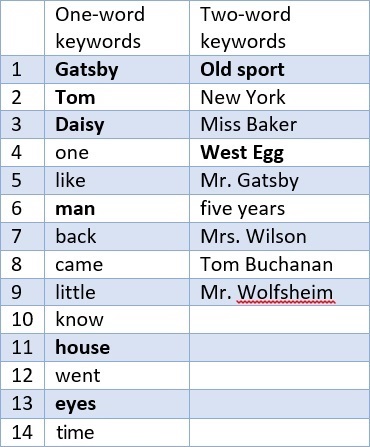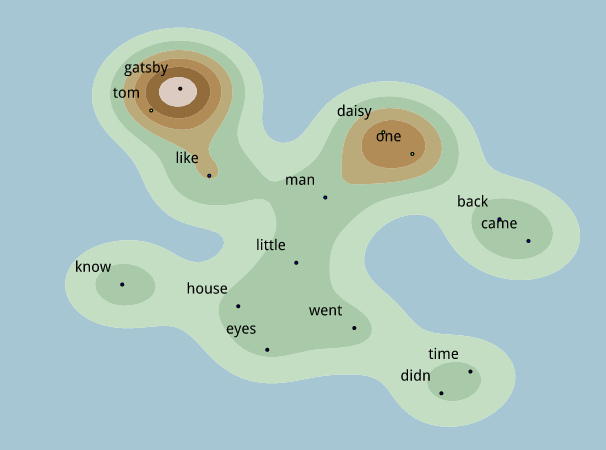The Power of a Page Analyzer: I Ran ‘The Great Gatsby’ through an SEO Tool & This Is What Happened was originally published on BruceClay.com, home of expert search engine optimization tips.
Ever wondered what would happen if you ran classic literature through an SEO tool? Me, too!
 I’ve got a sweet spot for tools that give me an idea of how I’m doing as a search marketer and content publisher. One test of an SEO tool’s power is if the software can do the job of a careful human expert in a fraction of the time.
I’ve got a sweet spot for tools that give me an idea of how I’m doing as a search marketer and content publisher. One test of an SEO tool’s power is if the software can do the job of a careful human expert in a fraction of the time.
The following experiment details what happened when an SEO tool meets F. Scott Fitzgerald’s “The Great Gatsby.” While it was devised in fun and out of true curiosity, it ended up being a real-life study of SEO tools at work, worth sharing.
The Setup
I’m a writer at digital marketing agency Bruce Clay, Inc., and I’m also an avid reader. Literature lovers like me can spend hours in book clubs picking apart themes and character dynamics. SEO analysis, meanwhile, should be as efficient as possible with time and resources. Can an on-page analyzer can tell me:
- How hard or easy text is to understand
- The relationship between characters (or in the case of websites, the relationship between keywords)
- And the theme
If a tool can accomplish that with a piece of literature, then it can certainly analyze a web page for appropriate language and SEO relevance. I used a free tool, the SEOToolSet’s Single Page Analyzer, and much to my delight, the SEO tool was able to peg character relationships, point to the theme of this American classic, and crunch 46,000 words in a fraction of the time a person requires. Super sweet.
Fair warning: Yes, there are some spoilers for “The Great Gatsby” but nothing that will keep you from enjoying the book – or Baz Luhrmann’s recent cinematic stunner. (Highly recommended, by the way.)
Reading Level
It’s relatively straight-forward for a computer program to grade the difficulty of text content. Readability is one of the word metrics reported by the Single Page Analyzer.
The SPA puts the text at a Fog reading level of 11.5 – which is right on target, as “The Great Gatsby” is most often taught during the junior year.
While the 11.5 grade level is fine for Fitzgerald, for your average web page, it’s a little higher than the recommended target. If this was your own website, you could use the reading level score to think about how accessible your text is to your target audience.
Characters and Their Relationships, or Keywords and Distribution
One of the basic tasks an on-page analyzer performs is identifying the most commonly used words and phrases on a page – in SEO world, a page’s keyword phrases.
The Single Page Analyzer reports the most-used words on a page, organized as one-word, two-word, three-word and four-word keyword phrases. Here are the one-word and two-word keywords of “The Great Gatsby” according to the SPA:
The first three one-word keywords are the main characters of the novel, a good indication that the analysis is on point. The SPA has correctly identified that “The Great Gatsby” follows the story of protagonist Gatsby, Tom, Daisy, and the narrator, Nick Carraway. In this analysis, we see Nick as he’s most often referred to as “old sport” – the most frequently used two-word keyword phrase and Gatsby’s favorite term of endearment. Also among the two-word phrases from the analyzer are more central characters and the main location of the action, West Egg.
So far, so good.
A Clue about Relationships, Care of the Keyword Heat Map
Here’s a unique feature of the SPA. Keywords get a visual treatment in the keyword heat map. The report lays out the identified keywords like a topographical map, where the words used the most are the highest peaks, and words that are physically located close together in the text are also placed near each other on the map.
Here’s the SPA’s keyword heat map for “The Great Gatsby”:
Notice that Gatsby and Tom and more closely connected than either of the men are with Daisy! A superficial reading of “The Great Gatsby” may suggest the book is a story of a romance between Gatsby and Daisy. But, this data visualization reveals the layer of meaning beyond that. There is a great distance between Gatsby and Daisy. Gatsby is much closer, in fact, to his foil, Tom, reflecting their constant competition and the story’s central tension. How’s that for in-depth character analysis?
Through these three metrics/reports we’ve assessed reading difficulty and important keywords/characters. Next, the real magic of the SPA’s analysis: understanding the theme.
Identifying the Theme
A theme is more than keywords; it is the underlying meaning or idea expressed. On a web page, a theme is pretty much determined by the topic (or subject) and the purpose (do/know/go, i.e., transaction, information, or navigation).
In a novel, a theme is more complex. We can’t understand a literary theme by looking at the keywords alone, but, of the nearly 46K words the SPA counted in “The Great Gatsby,” the most frequently used words can clue us in to where to look closer for the theme.
If you filter out character names from the list of one-word keywords, a few words stand out, namely: house, eyes, and time, all of which are critical thematic elements in “The Great Gatsby.” Together, the keywords of time, house and eyes do, in fact, point to major themes when explored further: an obsession with the past (time), a preoccupation with wealth and materialism (house), and the modernist shift away from God (eyes).
Time
“The Great Gatsby” is filled with references to time. An obsession with time is laced throughout the pages from start to end — particularly with the past. Recall narrator Nick Carraway’s opening lines: “In my younger and more vulnerable years my father gave me some advice that I’ve been turning over in my mind ever since,” as well as the closing lines: “So we beat on, boats against the current, borne back ceaselessly into the past.” The entire premise of the book is a man obsessed with a time gone by. (And note that other top keywords support this idea, too: came, went, back. The tense looks itself tends to look backward, and the actual adverb “back” is mentioned enough to appear in the top keywords.)
House
Chapter 1 holds Nick’s first description of Gatsby’s house, standing next to his own.
“My house was at the very tip of the egg, only fifty yards from the Sound, and squeezed between two huge places that rented for twelve or fifteen thousand a season. The one on my right was a colossal affair by any standard — it was a factual imitation of some Hotel de Ville in Normandy, with a tower on one side, spanking new under a thin beard of raw ivy, and a marble swimming pool, and more than forty acres of lawn and garden. It was Gatsby’s mansion.”
Countless descriptions of Gatsby’s house tell of a lavish palace in nouveau riche style —the setting of constant celebrity-studded galas that last until morning and set the night sky ablaze with lights. Both Gatsby’s house and Daisy’s house (over which Gatsby keeps near-constant vigil) play integral roles in the text. Gatsby’s house, after all, was bought for two reasons: its proximity to Daisy and its grand splendor, with which he hopes to impress her. And both homes speak to the “unprecedented prosperity and material excess” of American in the 1920s (SparkNotes).
Eyes
There are multiple descriptions of characters’ eyes throughout the book, but they’re all overshadowed by the recurring focus on Eckleburg’s eyes.
Remember T.J. Eckleburg? Eckleburg is a faded sign advertising an eye doctor that Gatsby & co. pass by every time they drive into New York from West Egg: “Above the grey land and the spasms of bleak dust which drift endlessly over it, you perceive, after a moment, the eyes of Doctor T. J. Eckleburg. The eyes of Doctor T.J. Eckleburg are blue and gigantic — their retinas are one yard high. They look out of no face but, instead, from a pair of enormous yellow spectacles which pass over a nonexistent nose … his eyes, dimmed a little by many paintless days under sun and rain, brood on over the solemn dumping ground.”
More than just a pair of eyes, Eckleburg is often seen as a god-like figure watching over the sordid affairs of the main players.

Photo by Eve Rinaldi (CC BY-SA 2.0)
Putting It All Together
Here’s my final analysis: “The Great Gatsby” would likely require a few days of engrossed reading to cover the above ground. However, the Single Page Analyzer’s computer processing power effectively discovered key elements and themes of the text, successfully performing a complex analysis of hundreds of pages of signal-dense text in minutes. Wasn’t that fun?!



No comments:
Post a Comment